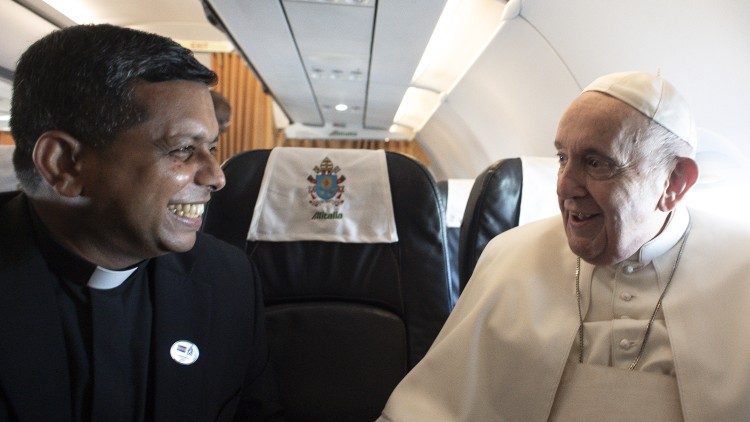The new cardinal from Kerala and the rift among Syro-Malabar
Francis’s decision to choose George Koovakkad, 51, his close aide in organising papal journeys, and not to the new major Archbishop Thattil, means that in a few months this young priest will be the only cardinal elector of this Church of the Eastern rite, which has been deeply divided in recent years by a row over the liturgy, a wound that is still open.
Mumbai (AsiaNews) – Among the 21 new cardinals announced on Sunday by Pope Francis, one of the most surprising names concerns India, that of Fr George Koovakkad, a close aide to the pontiff in charge of organising papal trips since 2020, after serving in the Vatican diplomatic service for a few years.
Koovakkad, who is 51 years old, hails from Thiruvananthapuram, the capital of Kerala State, and is a Syro-Malabar priest from the Archdiocese of Changanacherry.
This is not the first that a pontiff elevates to the cardinalship someone who organised papal journeys, but until now it had always been a way to honour prelates who had finished their service and were very close to 80, the age when a cardinal loses the right to participate in a conclave.
This time, however, the new cardinal will become one of the youngest in the College of Cardinals while still carrying out his duties alongside Pope Francis. Moreover, within a few months he will be the only representative among the cardinal electors of the Syro-Malabar Church, the largest Catholic community of Eastern rite in India, which has its heart in Kerala.
Next 19 April, the major Archbishop Emeritus George Alencherry will turn 80, while his successor Raphael Thattil, elected last January by the Synod of this Church, which has been deeply divided in recent years by a row over the liturgy, has not been included by Francis among the new cardinals.
Commenting on Koovakkad's appointment, Major Archbishop Thattil said that the Syro-Malabar Church “rejoiced and felt proud” of this son of the archdiocese. While the archbishop-elect of Changanacherry, Mgr Thomas Tharayil, in a message, wrote that his archdiocese of origin is "extremely grateful to the Lord for this happy moment".
Stressing that the elevation of a priest to cardinal is "unusual, at least in the history of the Indian Church," the prelate noted that Koovakkad deserves it because “he is a man of spiritual integrity and loyalty to the Church” and the new cardinal will be “a dynamic presence in the ecumenical Church.”
Beyond the official comments, among many Syro-Malabar believers the pope’s choice to elevate a priest like Koovakkad to the Office of Cardinal is also linked to the divisions that run deep within the Syro-Malabar Church.
“Traditionally the Major Archbishop of Syro-Malabar Church gets the cardinalship,” said a source from the Archdiocese of Ernakulam-Angamaly, the largest of the dioceses that follow this rite, speaking to AsiaNews.
“The first cardinal from Kerala was Archbishop Joseph Parecattil (1912-1987), then head of the Syro-Malabar bishops’ Council. Since then, all heads of the Syro-Malabar Church were made cardinals. But the present scenario in the Syro-Malabar Church is very precarious.”
“Although Pope Francis clearly told the Syro-Malabar Synodal bishops any attempt to have a uniformity in the liturgy should not damage the unity in the Church, the decision of the uniformity in the mode of celebration of the Holy Mas (Holy Qurbaba), the famous fifty-fifty formula (half versus populum and half versus altare) disrupted the unity in the Synod.
“The faithful and priests in the archdiocese resisted the liturgical decision of the Synod as they found out that the synod as a holy body of the church violated the very procedure in making a liturgical decision.”
The uniform mode of celebration officially dates back almost three years, but the row has continued to this day. “It was in November 2021 that the decision of the uniform mode of celebration came into effect. From that time onwards, there is chaos in the archdiocese,” the source said.
“Major Archbishop Administrator Archbishop Antony Kariyil stood for the priests and the faithful, and was forced to resign by the Synod. The Apostolic Administrator Andrews Thazhath tried to implement the decision with an iron fist and with the help of the police force, [but] he was an utter fiasco.”
“He was asked to resign and then the pontifical delegate came with an iron fist, but he could do nothing. The Major Archbishop Cardinal George Alencherry was asked to resign by the Vatican. Five of the synodal bishops expressed their difference of opinion in public” over the liturgy.
“The liturgical dispute was the hotkey in the new election of the Major Archbishop,” the local source said. “The first duty that was entrusted to him was to implement the synodal decision in the Archdiocese of Ernakulam-Angamaly. But he could not do anything, and he was seeking a path of dialogue with priests and the faithful of Archdiocese. This displeased the powerful lobby in the Synod.”
Hence, came the decision to give the faithful of the Syro-Malabar Church a new cardinal extraneous to this conflict.







.png)










